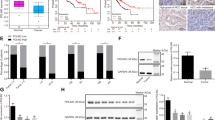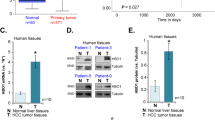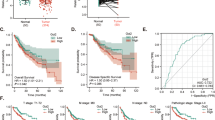Abstract
The gene deleted in liver cancer-1 (DLC-1) is located on human chromosome 8p21–22, a region thought to harbor tumor suppressor genes on the basis of its frequent deletion or loss of heterozygosity in a variety of human cancers, including hepatocellular carcinoma (HCC). Deletion or altered expression of DLC-1 is common in HCC. In the current study, the subcellular localization of Dlc-1 protein was determined by immunostaining with antibody to DLC-1 and the possible tumor growth suppressor activity of DLC-1 was investigated by examining the effects of of DLC-1 cDNA transfection in two human HCC cell lines lacking expression of the endogenous gene. The results show that Dlc-1protein is localized in the cell cytoplasm, and the restoration of DLC-1 expression in HCC cells resulted in caspase-3-mediated apoptosis, inhibition of cell growth and invasiveness in vitro as well as in reduction of the ability of the cells to form tumors in athymic nude mice. These observations thus support the notion that Dlc-1 protein is involved in hepatocarcinogenesis and has oncosuppressive activity in HCC.
This is a preview of subscription content, access via your institution
Access options
Subscribe to this journal
Receive 50 print issues and online access
$259.00 per year
only $5.18 per issue
Buy this article
- Purchase on Springer Link
- Instant access to full article PDF
Prices may be subject to local taxes which are calculated during checkout






Similar content being viewed by others
Abbreviations
- DLC-1:
-
deleted in liver cancer-1
- HCC:
-
hepatocellular carcinoma
- GFP:
-
green fluorescent protein
- RT–PCR:
-
reverse transcription–polymerase chain reaction
- DAPI:
-
4′6-diamidino-2-phenylindole
- FITC:
-
fluorescein isothiocyanate
- PI:
-
propidium iodide
- CGH:
-
comparative genomic hybridization
References
Boettner B and Van Aelst L . (2002). Gene, 286, 155–174.
Ching YP, Wong CM, Chan SF, Leung TH, Ng DC, Jin DY and Ng IO . (2003). J. Biol. Chem., 278, 10824–10830.
Euer N, Schwirzke M, Evtimova V, Burtscher H, Jarsch M, Tarin D and Weidle UH . (2002). Anticancer Res., 22, 733–740.
Gross A, McDonnell JM and Korsmeyer SJ . (1999). Genes Dev., 13, 1899–1911.
He L, Isselbacher KJ, Wands JR, Goodman HM, Shih C and Quaroni A . (1984). In Vitro, 20, 493–504.
Homma Y . (1995). EMBO J., 14, 286–291.
Huang DC and Strasser A . (2000). Cell, 103, 839–842.
Jaffe AB and Hall A . (2002). Adv. Cancer Res., 84, 57–80.
Kahng YS, Lee YS, Kim BK, Park WS, Lee JY and Kang CS . (2003). J. Gastroenterol. Hepatol., 18, 430–436.
Kang Y, Siegel PM, Shu W, Drobnjak M, Kakonen SM, Cordon Card C, Guise TA and Massague J . (2003). Cancer Cell, 3, 537–549.
Keck CL, Zimonjic DB, Yuan BZ, Thorgeirsson SS and Popescu NC . (1999). Cancer Genet. Cytogenet., 111, 37–44.
Moon SY and Zheng Y . (2003). Trends Cell Biol., 13, 13–22.
Ng IO, Liang ZD, Cao L and Lee TK . (2000). Cancer Res., 60, 6581–6584.
Oltvai ZN, Milliman CL and Korsmeyer SJ . (1993). Cell, 74, 609–619.
Peck J, Douglas GT, Wu CH and Burbelo PD . (2002). FEBS Lett., 528, 27–34.
Ponting CP and Aravind L . (1999). Trends Biochem. Sci., 24, 130–132.
Qin LX, Tang ZY, Sham JS, Ma ZC, Ye SL, Zhou XD, Wu ZQ and Trent JM . (1999). Cancer Res., 59, 5662–5665.
Qin LX, Tang ZY, Ye SL, Liu YK, Ma ZC, Zhou XD, Wu ZQ, Lin ZY, Sun FX, Tian J, Guan XY, Pack SD and Zhuang ZP . (2001). J. Cancer Res. Clin. Oncol., 127, 482–488.
Sekimata M, Kabuyama Y, Emori Y and Homma Y . (1999). J. Biol. Chem., 274, 17757–17762.
Soccio RE and Breslow JL . (2003). J. Biol. Chem., 278, 22183–22186.
Thorgeirsson SS and Grisham JW . (2002). Nat. Genet., 31, 339–346.
Toksoz D and Merdek KD . (2002). Histol. Histopathol., 17, 915–927.
Wilson PJ, McGlinn E, Marsh A, Evans T, Arnold J, Wright K, Biden K, Young J, Wainwright B, Wicking C and Chenevix-Trench G . (2000). Hum. Mutat., 15, 156–165.
Yuan BZ, Durkin ME and Popescu NC . (2003a). Cancer Genet. Cytogenet., 140, 113–117.
Yuan BZ, Miller MJ, Keck CL, Zimonjic D and Thorgeirsson SS . (1998). Cancer Res., 58, 2196–2199.
Yuan BZ, Zhou X, Durkin ME, Zimonjic DB, Gumundsdottir K, Eyfjord JE, Thorgeirsson SS and Popescu NC . (2003b). Oncogene, 22, 445–450.
Zimonjic DB, Keck CL, Thorgeirsson SS and Popescu NC . (1999). Hepatology, 29, 1208–1214.
Acknowledgements
We thank Dr Stanley Korsmeyer for advice and critical reading of the manuscript, Dr Susan Garfield and Stephen Wincovitch, for assistance with confocal microscopy and Barbara J Taylor, for the assistance with flow cytometry analysis.
Author information
Authors and Affiliations
Corresponding author
Rights and permissions
About this article
Cite this article
Zhou, X., Thorgeirsson, S. & Popescu, N. Restoration of DLC-1 gene expression induces apoptosis and inhibits both cell growth and tumorigenicity in human hepatocellular carcinoma cells. Oncogene 23, 1308–1313 (2004). https://doi.org/10.1038/sj.onc.1207246
Received:
Revised:
Accepted:
Published:
Issue Date:
DOI: https://doi.org/10.1038/sj.onc.1207246
Keywords
This article is cited by
-
Metastasis suppressor genes in clinical practice: are they druggable?
Cancer and Metastasis Reviews (2023)
-
Dynamic adaptation of mesenchymal stem cell physiology upon exposure to surface micropatterns
Scientific Reports (2019)
-
CARM1-expressing ovarian cancer depends on the histone methyltransferase EZH2 activity
Nature Communications (2018)
-
Transcriptomic analysis reveals sex-specific differences in the expression of Dcl1 and Fis1 genes in the radio-adaptive response of thymocytes to TRP53-mediated apoptosis
BMC Genomics (2016)
-
Aberrant DNA methylation of alternative promoter of DLC1 isoform 1 in meningiomas
Journal of Neuro-Oncology (2016)



